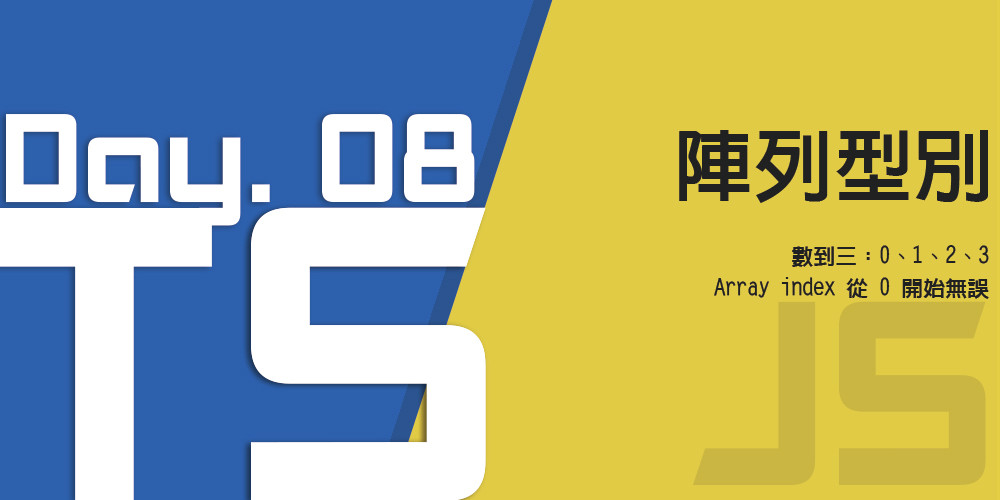[Day08] - 通通裝起來 - Array(陣列).md

這個那個不要,剩下的通通裝起來。
數到三:0、1、2、3Array index 從 0 開始無誤───────────────────────── By Opshell
目標: Array Type 法
在 TypeScript 中, 大約有四種方式可以來定義
陣列型別
過程:
1. Array Inference(推論)
當你宣告陣列,內容為同型別的元素時, TypeScript會自動
Inference(推論), 將他們當T[]來Inference(推論)。 語法:變數 = [](像一般JS般的宣告)typescript// TS "推論" team 為 string[] 型別。 const team = [ 'Opshell', 'Bear', 'Egg', 'Patty' ];1
2那會有人問啦,如果我是混合型態的陣列呢?
typescriptconst team = [ 0, 'Opshell', 'Bear', 233 ];1※ 這時候TS會聰明的
Inference(推論)成Union Type(聯型別集)(string | number)[] 喔。這時候就要提到一個原先JavaScript不存在的概念
Tuple(元組)Array(數組)放型別相同的,而Tuple(元組)則是放不同的。 而使用上面的例子:typescriptconst team: [ number, string, string, number ] = [ 0, 'Opshell', 'Bear', 233 ]; const team2: [ number, string, string, number ] = [ 1, 'Patty', 'Egg', 7351 ];1
2是
Tuple(元組)的Annotation(註記)方式, 但是這種方式在資料多點的時候麻煩到炸阿... 簡單點的方法是利用Type Alias(別名)的技巧: 語法type 別名: 型別;typescripttype teamTuple = [ number, string, string?, number? ]; const team: teamTuple = [ 0, 'Opshell', 'Bear', 233 ]; const team2: teamTuple = [ 1, 'Patty' ];1
2
3
4如果再宣告型別後面加
?即表示可選參數喔~ 那Array(數組)和Tuple(元組)有哪些差異呢?型別 Array(數組)Tuple(元組)註記方式 (number l string) [ number, string, string, number] 限制 只要型別一樣即可 順序必須和宣告的吻合,且不能多 不過使用元組的機會非常少,至少Ops是這樣認為的, 基本上當你塞進去的資料型別不一樣,那大部分都是有意義的, 這時候使用
Object(物件)或者是Interfaces(介面)不是更清楚和方便呼叫嗎@"@?
2. Array Annotation(註記)
語法:
變數: 型別[] = []typescript// string[] 表示此陣列型別只允許字串 const team: string = [ 'Opshell', 'Bear', 'Egg', 'Patty' ]; // 將team 註記為 Union Type Array let team: (string | null)[] = [];1
2
3
4
5※ 一般情況來說,TS的
Inference(推論)會準確的推論使用者的需求, 只有為了下面的情況會比較積極的Annotation(註記):- 宣告空陣列:為了避免
any - 需求不定型別:使用
Union(聯集)註記
※ 不過會使用TypeScript 很大一部份的原因也是為了提高程式碼的可讀性, 所以一般況還是會使用
Annotation(註記)法。- 宣告空陣列:為了避免
3. Array Generic(泛型陣列)
語法:
變數: Array<型別> = []typescriptconst team: Array<string> = [ 'Opshell', 'Bear', 'Egg', 'Patty' ];1Generic(泛型)是個比較龐大的主題,今天就先混個臉熟。
4. interface (介面)
使用
Interface(介面)來描述陣列的形狀,typescript// IStringArray 表示: // 只要索引的型別是字串時, // 那麼值的型別必須是字串。 interface IStringArray { [index: string]: string; } const team: IStringArray = ['Opshell', 'Bear', 'Patty', 'Egg' ];1
2
3
4
5
6
7※ 雖然
Interface(介面)也可以用來描述陣列, 但是我們一般不會這麼做,因為這種方式比前面的方式麻煩。 不過有一種情況例外,用它來表示類別陣列。※
Interface(介面)也是個複雜的主題,混個臉熟、混個臉熟。
小結:
學習完陣列的宣告方式, 除了複習到平常常用的
Annotation(註記)、Inference(推論)外, 對於也很常用的Union(聯集)也越來越熟練, 也提高了閃避any的技術, 也和一些後來的花俏技術論了臉熟。 算是蠻有收穫的一天。

